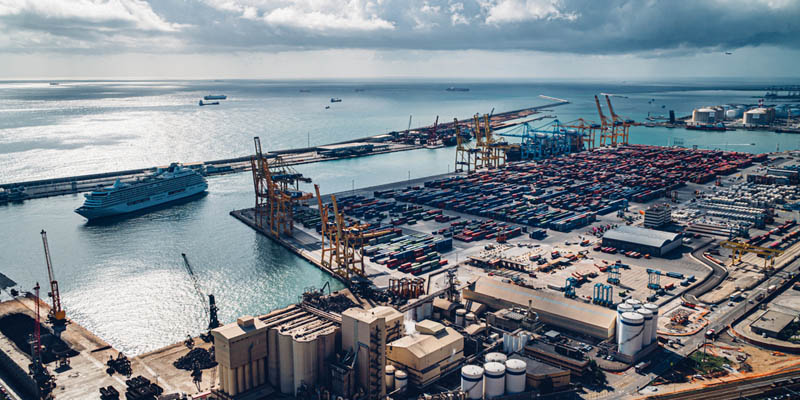We explain what free zones are, and discuss their requirements, conditions, and objectives. In addition, we explore their characteristics and services.

What are free zones?
Free zones are geographically designated areas within a country in which benefits are granted to businesses, typically related to taxation. Companies within free trade zones, for example, may import or export products without paying taxes.
They are usually established in remote areas, far from urban centers, with limited infrastructure and few public services. These are locations that companies would hardly choose were it not for the tax benefits and fiscal incentives.
Free trade zones promote the enhancement of infrastructure and services, as well as the creation of job opportunities in areas with low socioeconomic development.
These zones are designated by the government of each country, which approves their creation and adopts the laws and regulations under which they operate. While free trade zone operators are usually private companies, they are nevertheless subject to the control and regulation of local governments.
- See also: Panama Canal
Characteristics of free zones
The main characteristics of the free trade zones are:
- They exist in a large number of countries around the world and are often used by companies from various sectors, such as logistics and technology.
- The objective of free zones is to promote investment, economic growth, and foreign trade.
- Most of them are physically separated from the country's territory.
- For customs purposes, they are considered extraterritorial areas: businesses established within free zones may import and export products without paying taxes.
Types of free zones
Various types of free trade zones exist.
Depending on the duration of business operations:
- Permanent free zones. They offer long-term fiscal and regulatory incentives to companies. They do not have a time limit for business operations.
- Special permanent free zones. They offer benefits to companies in certain sectors. They have no time limit for business operations.
- Temporary free zones. They aim to support a specific sector or project for a certain period of time.
Depending on the type of institution that operates them:
- Private free zones. They are operated and managed by private companies authorized by the state.
- State-owned free zones. They are operated directly by the state.
- Mixed free zones. They combine state and private administration.
How does a free trade zone work?

Free trade zones must meet certain requirements to be established:
- The area must be large enough to accommodate a significant number of companies and activities.
- They must have access to transportation infrastructure such as roads, railways, ports, or airports.
- They must have access to essential services such as water, electricity, security, and connectivity.
Once the free trade zone is organized, companies may set up. This involves the hiring of labor for the construction and installation of factories, offices, and the necessary transportation and service infrastructure. After the setup and equipping of the free trade zone is completed, companies may start business operations.
States often oversee the proper functioning of free trade zones. For this reason, government offices are usually present within these zones, including customs, immigration, health, and security offices.
Customs offices are particularly important for the operation of free trade zones as they regulate the entry and exit of goods. These offices handle customs procedures such as inspection and authorization of imports and exports.
Immigration offices are necessary to regulate the entry and exit of individuals from other countries. Foreign companies operating in free trade zones may need personnel to travel from and to other countries for which they need to carry out immigration procedures.
Health offices ensure that products manufactured within the free trade zone comply with health standards and regulations, for example, regarding the proper use and handling of products and materials or the disposal of waste.
Security offices are charged with controlling the entry and exit to and from the free trade zone as well as with prevention and response in case of emergency.
What is the purpose of free zones?

The main objectives of free trade zones are:
- Promote foreign and domestic private investment. Free zones aim to attract investment from both foreign and local companies by offering fiscal incentives, such as tax exemptions and tariff reductions.
- Promote foreign trade. They aim to promote international trade through the import and export of products and services.
- Facilitate logistics and transportation. They seek to improve logistics and transportation for companies established within the free zone. To this end, roads, ports, and airports are built that may facilitate access between the free trade zone and its markets.
- Develop infrastructure in the region. They promote the development of other types of infrastructure in the region, such as the construction of hospitals, schools, and housing for workers.
- Generate employment opportunities. They provide job opportunities in companies within the free trade zone as well as in sectors related to construction, logistics, and transportation.
- Contribute to economic growth. They seek to have a positive impact on the local and national economy by fostering trade, private investment, and job creation.
Companies in free trade zones are typically service companies in sectors like logistics, transportation, packaging, and distribution of manufactured products. Other types of businesses include telecommunications, data transmission and storage, and information technology, as well as financial, banking, and insurance services.
While domestic trade is not among the main objectives of free trade zones, some include shopping centers and commercial areas where goods are sold at lower prices, as they are tax-free.
Examples of free zones
The world's first free trade zone was established in the city of Hamburg, Germany, in 1888. Following the German experience, other countries including the United States, Hong Kong, and Singapore, established free trade zones within their territories. Today, there are more than 3,000 free trade zones around the world, with the United States, China, and India having the largest number.
Explore next:
Was this information useful to you?
Yes NoThank you for visiting us :)